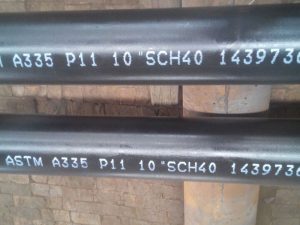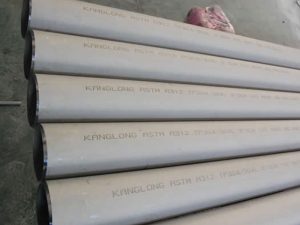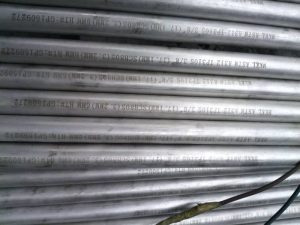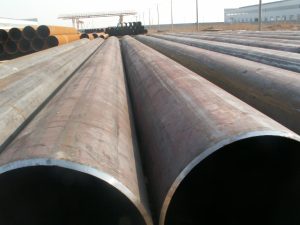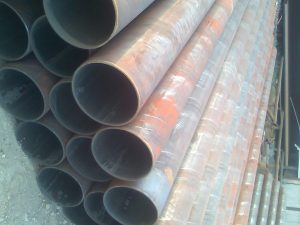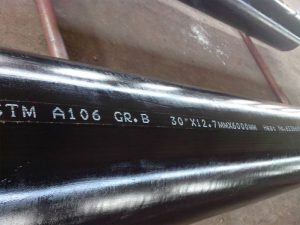Hastelloy B-3 is a nickel-molybdenum alloy with excellent resistance to pitting, corrosion,
and stress-corrosion cracking plus, thermal stability superior to that of alloy B-2. In addition,
this nickel steel alloy has great resistance to knife-line and heat–affected zone attack. Alloy B-3
also withstands sulfuric, acetic, formic and phosphoric acids, and other non-oxidizing media.
Furthermore, this nickel alloy has excellent resistance to hydrochloric acid at all concentrations
and temperatures. Hastelloy B-3’s distinguishing feature is its ability to maintain excellent
ductility during transient exposures to intermediate temperatures. Such exposures are routinely
experienced during heat treatments associated with fabrication.
Chemical Composition, %
Ni Mo Fe C Co Cr Mn Si Ti W Al Cu
65.0 min 28.5 1.5 .01 max 3.0 max 1.5 3.0 max .10 max .2 max 3.0 max .50 max .20 max
2.What is
ASTM B163/ASME SB-163
This specification covers seamless tubes of nickel and nickel alloy for use in condenser and heat-
exchanger service. This covers outside diameter and average wall, or outside diameter and minimum wall
tube. Tube shall be furnished in the alloys and conditions defined by this specification. The material shall
conform to the composition limits of nickel, copper, molybdenum, iron, manganese, carbon, silicon,
chromium, aluminium, titanium, phosphorus, cerium, zirconium, yttrium, born, cobalt, columblum, tungsten,
and nitrogen specified. Tensile strength, yield strength, elongation, and Rockwell hardness of the material
shall conform to the required mechanical properties set by this specification. Test methods such as
chemical analysis, tension, rounding procedure, Rockwell hardness, grain size and hardness conversion
shall be performed.
3.UNS N10675 Hastelloy B3 Pipe SPECIFICATION
Dimensions: ASTM, ASME and API
Standard: ASTM B163/ASME SB-163
Size: 15 NB to 150 NB IN
Outer diameter: 1/2″ – 48″.
Specialized in: Large Diameter Size
Grade: UNS N10675 Hastelloy B3
Schedule: SCH 5 – SCH XXS
Form: Round, Square, Rectangular, Hydraulic Etc
Type : Welded / ERW / Fabricated
Length : Single Random, Double Random & Cut Length.
End: Plain End, Beveled End, Threaded
Out diameter Wall thickness Length
NB Sizes (in stock) 1/8” ~ 8” SCH 5 / SCH 10 / SCH 40 / SCH 80 / SCH 160 Upto 6 Meters
Seamless (Custom Sizes) 5.0mm ~ 203.2mm As per requirement Upto 6 Meters
Welded (in Stock + Custom Sizes) 5.0mm ~ 1219.2mm 1.0 ~ 15.0 mm Upto 6 Meters
4.UNS N10675 Hastelloy B3 Pipe Application
Petrochemical Oil & Gas Paper Refineries Nuclear Power
Cement Sugar Power Plant Fertilizers Breweries
Chemical Petrochemical Shipbuilding Defence Mining
Steel Plant Construction Oil Mills Paper Engineering Co.
5.Documentation
• Commercial Invoice which includes HS Code
• Packing List including net weight and gross weight, number of boxes, Marks and Numbers
• Certificate of Origin legalized/attested by Chamber of Commerce or Embassy
• Fumigation Certificates
• Raw Material Test Reports
• Material Traceability Records
• Quality Assurance Plan (QAP)
• Heat Treatment Charts
• Test Certificates certifying NACE MR0103, NACE MR0175
• Material Test Certificates (MTC) as per EN 10204 3.1 and EN 10204 3.2
• Guarantee Letter
• NABL approved Laboratory Test Reports
• Welding Procedure Specification/Procedure Qualification Record, WPS/PQR
• Form A for the purposes of the Generalized System of Preferences (GSP)
6.Hot-Rolling Steel
Hot rolling is a mill process which involves rolling the steel at a high temperature (typically at a temperature
over 1700° F), which is above the steel’s recrystallization temperature. When steel is above the
recrystallization temperature, it can be shaped and formed easily, and the steel can be made in much larger
sizes. Hot rolled steel is typically cheaper than cold rolled steel due to the fact that it is often manufactured
without any delays in the process, and therefore the reheating of the steel is not required (as it is with cold
rolled). When the steel cools off it will shrink slightly thus giving less control on the size and shape of the
finished product when compared to cold rolled.
Uses: Hot rolled products like hot rolled steel bars are used in the welding and construction trades to make
railroad tracks and I-beams, for example. Hot rolled steel is used in situations where precise shapes and
tolerances are not required.





